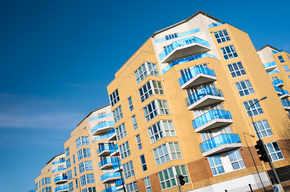The WPJ
THE WORLD PROPERTY JOURNALReal Estate Facts Not Fiction
Commercial Real Estate News

U.S. Multi-Family Sector's Vacancy Rates Expected to Rise in 2013
Commercial News » North America Commercial News Edition | By Hortense Leon | December 5, 2012 8:18 PM ET
 Although the U.S. multi-housing vacancy rate is expected to go up in 2013, it will remain near the historic average.
Although the U.S. multi-housing vacancy rate is expected to go up in 2013, it will remain near the historic average.That higher rate is expected to be 5.3% in 2013, according to a new report from CBRE Group, Inc. The increase, from a rate of 4.5% in third quarter 2012, will be the result of new units being completed and a slight decrease in demand compared to historically high levels in recent years. But CBRE also forecasts that the multi-housing vacancy rate will fall back to 5.2% in 2014.
The multi-housing vacancy rate is projected to be 5% for 2012, down from 5.4% in 2011 and from 7.3% at its 2009 peak, according to CBRE.
"It is a great time to own multi-housing properties: apartment demand is benefitting from the slowly recovering economy as well as a rapidly expanding pool of renter households," says Gleb Nechayev, senior managing economist at CBRE Econometric Advisors.
Rents have gone past previous peak levels in most markets and vacancy rates are below historic averages, according to the CBRE report. The apartment market began an expansion phase in late 2011 and since then, fundamentals have continued to show steady improvement. New supply has also picked up a lot as a result of strong fundamentals. Completions are expected to return in 2013 to the 1998-2008 annual average of about 190,000 units, according to CBRE. In spite of this, growth in demand is expected to slow in the new year.
As vacancies approached historically low levels in the third quarter of this year, levels last seen in 2006 and 2007, growth in apartment demand had slowed to a rate of about 120,000 units per year in third quarter 2012, from 160,000 units the quarter before, according to a "Flash Multi-Housing Vacancy Index" report put out by CBRE Econometric Advisors on October 4, 2012. Effective rent growth had also slowed down, according to CBRE, with the national same-store index rising at an annualized rate of about 3.5% compared to 4% in the second quarter.
Markets with the strongest rent growth (6% or more on an annualized basis) in third quarter included San Francisco, San Jose, Oakland, Charlotte, New York, Hartford, Columbus, Denver and Louisville, according to CBRE. Markets with the slowest rent growth (1% or less on an annualized basis) included Las Vegas, Sacramento, Norfolk, Birmingham, Greensboro and Tulsa.
Sign Up Free | The WPJ Weekly Newsletter
Relevant real estate news.
Actionable market intelligence.
Right to your inbox every week.
Real Estate Listings Showcase
Related News Stories
Commercial Real Estate Headlines
- U.S. Commercial Mortgage Delinquencies Rise in Q2, CMBS Loans Lead the Surge
- Tokenization-Focused Real Estate Investment Bank Announced
- Commercial Cap Rates Edge Lower in U.S., Hinting at Market Turn
- WPV Targets New $6 Trillion Digital Real Estate Tokenization Opportunity
- $1 Trillion in Data Center Development Underway Through 2030
- WORLD PROPERTY VENTURES: The 'Anti-VC' of Real Estate Plans Major Capital Raise
- Multifamily Sector Enjoys Record Absorption in U.S. as Supply Slows, Vacancies Drop
- Employee Back-to-Office Attendance Surges in U.S.
- Phnom Penh Commercial Property Sectors Face Crosswinds in 2025
- World Property Bank Announced to Capitalize on Coming Trillion-Dollar Tokenization Boom
- REAL ESTATE PREDICTIONS: Decentralized Events Contract Exchange in Development
- U.S. Architecture Billings Improve Slightly in May
- Tokyo Office Demand Spills into Non-Core Wards in 2025
- AI Hyperscalers Drive Record Data Center Leasing in Early 2025
- Commercial, Multifamily Mortgage Debt in U.S. Hits Record $4.81 Trillion in Early 2025
- U.S. Multifamily Market Rebounds in Early 2025
- U.S. Office Market Experiences Historic Conversion Shift
- New York City Enters New Era of Office-to-Residential Conversions
- World Property Ventures Plans New Capital Raise
- U.S. Commercial Real Estate Lending Rebounds Sharply in Early 2025
- U.S. Multifamily Housing Confidence Declines in Early 2025
- Asia Pacific Commercial Investment Holds Steady in Early 2025
- Carnival Plans New Miami Headquarters Spanning Over 600,000 Square Feet
- Hong Kong Property Investors Take a Wait-and-See Approach Due to U.S. Tariffs
- U.S. Multifamily Buyer and Seller Sentiment Improves in Early 2025
- One Trillion Dollars of America's Commercial Property Loans Mature in 2025
- U.S. West Coast Dominates Self Storage Demand
- Phoenix, Orange County and Inland Empire Emerge as Leading U.S. Industrial Markets
- U.S. Mega Distribution Centers Leasing Activity Grew in 2024
- U.S. Commercial Borrowing to Increase to $583 Billion in 2025, Up 16 Percent Annually
- Demand for U.S. Life Sciences Space Spikes 28 Percent Annually in Late 2024
- Multifamily Property Sector in America Rebounding
- Asia Pacific Commercial Property Investment Spikes 23 Percent in 2024
- U.S. Commercial Property Market Primed for Growth in 2025
- Architecture Industry Sees Mixed Signals as 2025 Approaches
- Global Data Center Demand Spikes in 2025
- 2025 Prediction: U.S. Commercial Investment Recovery Expected to Gain Traction
- Holiday Retail Sales for 2024 to Hit Record $1 Trillion
- Tech, AI Industries Drive Largest Share of Office Leasing Activity in U.S.
- Commercial Real Estate Lending in U.S. Enjoys Strong Growth in Q3
Reader Poll
Marketplace Links
This website uses cookies to improve user experience. By using our website you consent in accordance with our Cookie Policy. Read More







